We come to the last article in this series! Before getting to work I would like to thank Paul Savulescu for his great advice on machines and the operation of the PIDs and José Luis Antonaya for asking the question that motivated us to write these posts. We are going to try to specify all the concepts that have been launched in previous writings to be able to apply them in our espresso recipes, although most of them would also work for filter coffees if we know how to extrapolate the variables.
First of all, we must remember the recommendations of SCAA and SCAE to have an extraction objective and also keep in mind the different values that the concentration of solubles (%TDS) can take to find an intensity in our espresso with which let's be happy. We are going to try to aim for an extraction of 20% since above this figure it will be very difficult to get by with the means we usually have without feeling bitter. If someone is lucky enough to have an EK43 or similar and a machine with adjustable water flow, they can play with increasing this extraction goal. Since not everyone has a refractometer, we will use flavor as our first reference and its data as objective support.
DOSAGE. HOW MUCH COFFEE AM I GOING TO GRIND? *
*I will talk at all times about dosage for double scoop/espresso.
The amount of coffee used for each drink will result in a more or less voluminous espresso. We could play with this variable to obtain a more or less extracted drink, but I think it is better to leave it fixed and define it based on the commercial angle of the business (profitability) or workflow. For the issue of extraction it is better to play with the grinding and the ratio, which will give us quite a few headaches on their own.
Regarding the issue of grammage and its commercial profitability, the ideal would be to calculate a scale in which the cost of your coffee is proportionate to the sales volume and RRP. Changing the dosage every time we want to regulate the extraction does not make it easier to calculate the variable costs of a cafeteria. Even so, it is not going to affect us too much in the overall calculation of our profitability, which is why I find it more interesting to set the dosage based on the workflow of the cafeteria.
I found the system they used at Prufrock, London, a very progressive coffee shop where they serve an average of 400 coffees a day, all of them to a very high standard, very interesting. There they are very interested in having an efficient workflow and their dosages adapt to this. For the coffee that rotates the most, usually a Square Mile blend, they use a very high grammage (22g) and divide it into two shots of 22g each espresso. They know that this coffee will be constantly requested and they squeeze it with a high dosage to have two espressos or two rich coffee milk drinks. Since they have a continuous clientele, they will rarely have a shot left over. For the other coffee, which we could call “guest” or seasonal, and with much less rotation, they use a very low grammage (16 g) and always serve a 32 g double shot, whether in espresso or milk drink. In the end, as a customer, you are going to find yourself with a drink of approximately 22 or 32 grams, where the 32 is a little more expensive - guest coffee - and in this way they avoid using one's filter holder (I don't even know why what exist) or that they occasionally have a shot left over.
THE RATIOS. EVOLUTION AND REVOLUTION.
Traditionally, weight ratios were not used and the regulation of an espresso recipe was based on volume and time. These two variables are a good approximation when starting to work with coffee, but for fine spinning it is more stable and accurate to work with weights. How much ingredient I use (dry coffee mass) and what yield I obtain from it (drink mass) are the variables and the relationship between the two is the famous ratio, whose use in filtered coffees is much more widespread and accepted than in espressos. , when it is much more difficult to do one of the latter.
Calculating the ideal ratio for an espresso will depend, fundamentally, on the type of bean we have (origin, varietal, process...) and the roasting that has been applied. Until not long ago, I used to work with short ratios (1:1.5 and lower) and many of you who are reading probably did too, even if it was unconsciously. The classical school had taught us that an espresso was 30 ml and exceeding 25 seconds of extraction was Evil. However, they were right, since the coffees produced by this school were of average quality - not special - and the roasts were on the higher side. morenitos, so an underextraction resulting from these parameters compensated for the bitterness of the roast and the defects of that product.
In short, we were using short ratios to correct someone else's error, the problem is that as the specialty reached our homes the espressos became more and more acidic, since the product evolved to more respectful roasts but our procedures did not. Suddenly, going to a specialty coffee shop became an exercise in lemon-sucking. Luckily, this era is behind us and we now have tools and knowledge to make sweet and delicious drinks, as well as a wide range of specialty coffees and light roasts that bring out the potential of the bean.
PERFORMANCE. HOW MUCH DO I EXTRACT?
Following the SCAA standards that we proposed in the Extraction I post, the one that is between 18 and 22% is accepted as correct, whether for filter or espresso. As we saw in that article, this percentage is directly related to the coffee/water ratio that we have used, so to aim for this extraction range we have to start doing tests with different proportions, in addition to the other variables that we are given. They offer: grinding, temperature, time, etc.
I'm going to focus on espressos since they are the majority of drinks prepared in specialty coffee shops and, in my opinion, are much more difficult to extract correctly and consistently than filter or immersion coffees. . To define them we will base ourselves on the table below where on the vertical axis we find the concentration (%TDS) that will define this drink and on the horizontal axis we find the extraction percentage for a balanced and pleasant flavor. I have set the lower limit of espresso at 7% and not at the traditional 8%, because I think the tendency is to lengthen this drink .
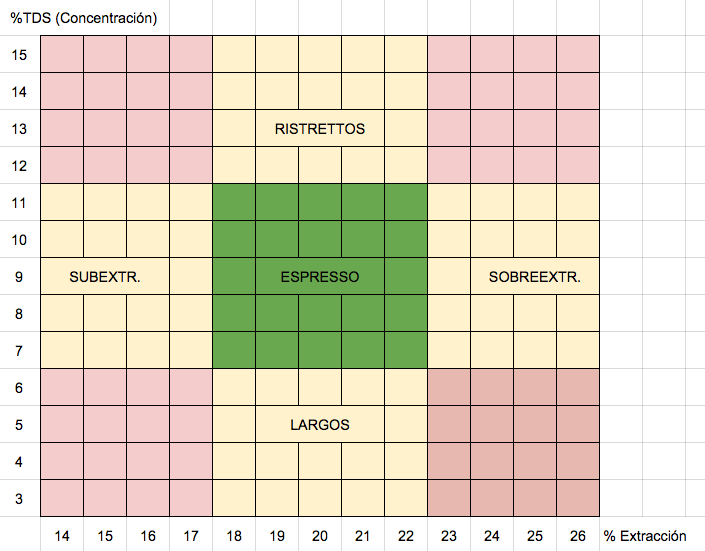
To get it right in the area of correctly extracted espresso we will have to carry out several tests, play with the variables that we have at our disposal and check the results with our palate or with the help of a refractometer (I recommend any barista or roaster who wants to improve to use it since, although coffee is enjoyed with the senses, objective data helps clear up many doubts).
Let's take as an example that we dose 20 grams of coffee and keep that figure constant, since it will make the calculations easier as it is a fairly round number and varying the dosage will not help us find our recipe, as I already explained before. With “normal” parameters in the execution of espresso: 90-95ºC temperature, 9 bars of pressure, 22-35 seconds of extraction, correct distribution and pressing, etc., we will begin to test different ratios and see what happens. .
As an example we will use a washed catuaí from Honduras Cooperativa Capucas with a light roast since it is a fairly balanced coffee.
One of the most traditional is the 1:1.5 ratio , so we will start there to try. We dose 20 grams into the filter holder and extract a 30 gram espresso in 25 seconds . Result in the mouth: quite high acidity, also high body, little sweetness and a very short finish. It's not bad, but it's not a pleasant drink either. Let's see what happens with this shot when we put it through the refractometer: 11.10%TDS which results in an extraction of 17.3%. If we place this pair of data in the table it is easy to see where our espresso is located.
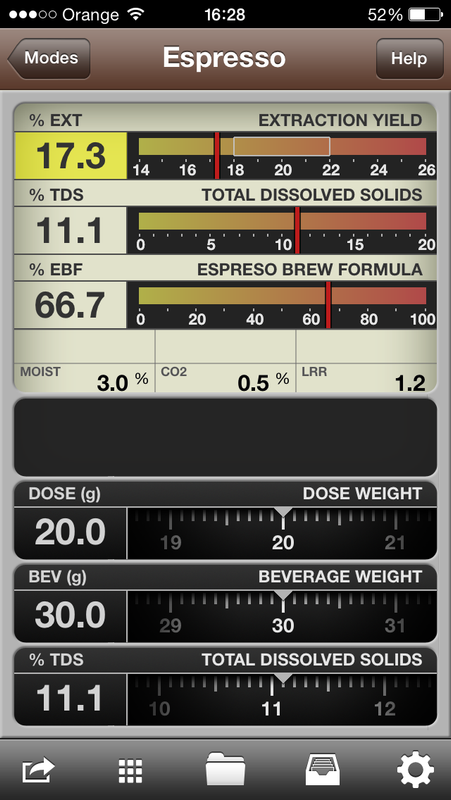
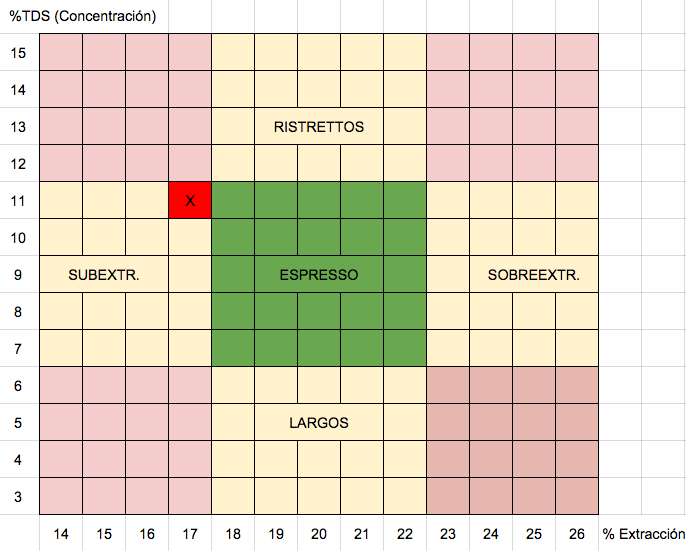
Obviously, everything indicated that this recipe led to underextraction .
To avoid this problem we are going to increase the ratio and try a 1:2 , so from 20 grams we will extract a 40 gram drink. Obviously to achieve this we will need more time, so our goal is achieved in 30 seconds . Result in the mouth: more balanced acidity, medium body, sweetness and a long finish. This espresso is delicious. If we put it through the rigors of science we observe the following: 9.61%TDS , which leads us to an extraction of 19.9%. We have hit the target. Obviously, by extracting more by passing more water through our coffee we have lost body, but it is the price to pay to have a sweeter and more balanced drink.
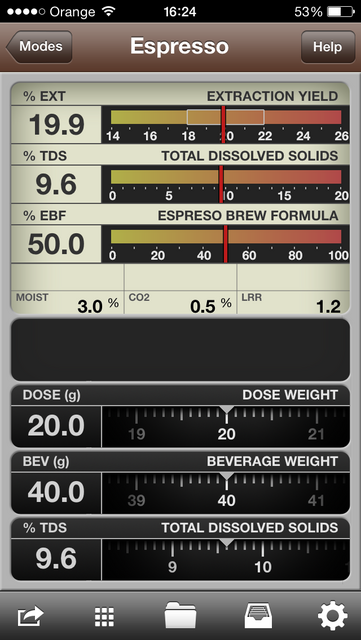
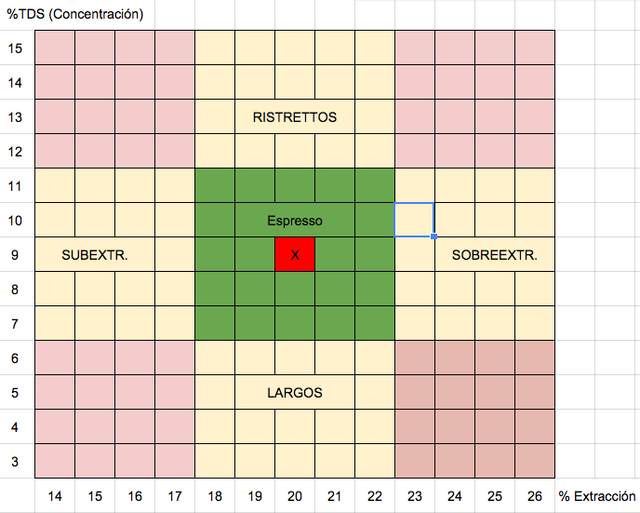
Our drink is already delicious, but what would happen if we squeezed our coffee even more ?
The first thing we have to keep in mind is that the more we ask of our product, the more careful we have to be with channeling and partial overextractions. It is crucial to distribute, press and place the filter holder in the group very carefully. We must also forget about mediocre mills or those with worn/misaligned grinding wheels, since they generate a much greater distribution of particle sizes, so homogeneity is reduced and we lose control of the extraction.
Let's try a 1:2.5 ratio . We put 20 grams in the filter holder and obtain a 50 gram drink in 32.5 seconds . Flavor: medium-low acidity, sweetness and some chocolatey notes, without being unpleasantly bitter. The body is short. What does the refractometer tell us? 8.2%TDS and an extraction of 21.2% . We are still within what is “acceptable” although this is where everyone can choose where to stay. Perhaps the previous drink is more complete and interesting, and this one, with more chocolatey nuances, may work better with milk.
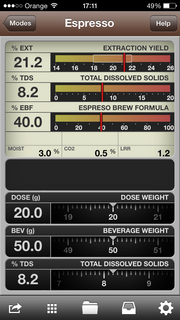
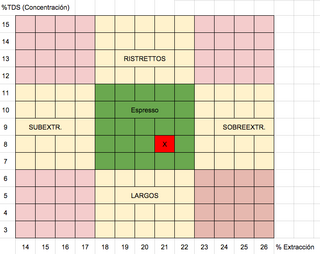
We can still stretch the ratio further. For coffees with high acidity or light roasts we can find that the sweetest drink is close to the 1:3 ratio . The other day I had a conversation with a guy who works with Heart Coffee Roasters in Portland (recent winners of the Sprudgie for best roaster of 2015) and he told me that they recommend extracting all their coffees with ratios of 1:3. It is true that in those lands they work with very well roasted coffees and with machines with variable water flow and pressure. With these ratios we lose body and aim towards a filtered coffee profile, but the sweetness and flavors that we bring to light make it worth it. Personally, I put flavor before body without a doubt.*
To finish with the previous example, if we dose 20 grams of coffee and squeeze it up to 60 grams in a cup , it takes 35 seconds and gives us 7.5% TDS , which results in a 23.3% extraction . According to the SCAA parameters we would be outside the acceptable range and it is true that for this coffee we find bitter and dry notes, but we have to lose our fear and risk increasing our extractions because there are certain beans and roasts that can surprise us with this ratio. What I do recommend is having equipment and routine that lives up to these expectations.
The good thing about this ratio is that it gives us a higher yield and helps us make the coffees more profitable, be able to bet on beans of higher quality and price and be more efficient/ecological.
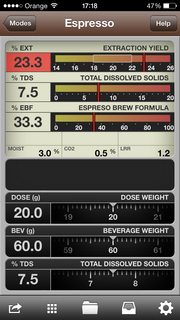
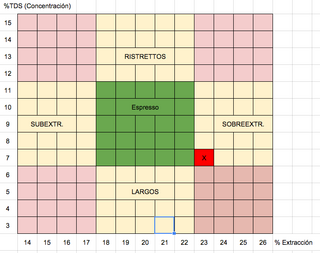
*It is observed that as we increase the rate of our extractions, the body progressively decreases, which makes sense since we put more water in our drink. In order not to lose body, the only way to compensate is to adjust the grinding towards finer parameters, taking into account that with this we increase the specific surface area of the coffee in contact with water, the time will be longer and the extraction will grow faster. In this way the results would go up in the graph as seen here:
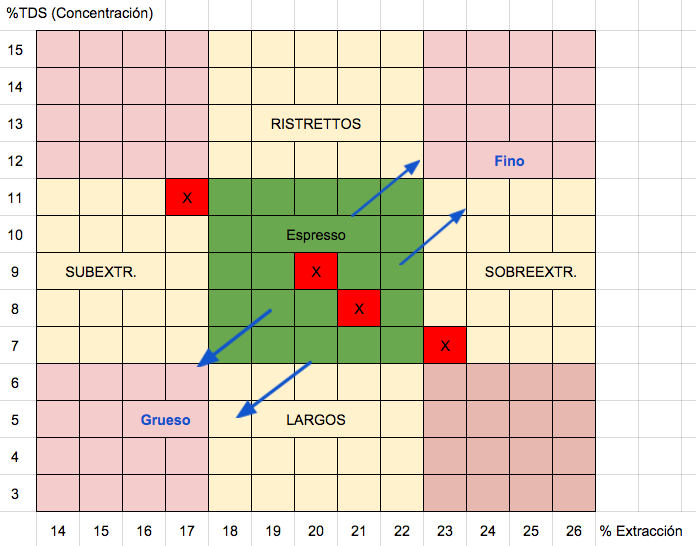
It can also be deduced from the graph that the results follow patterns, forming diagonals from top left to bottom right. Depending on how we refine or coarsen our grind, that diagonal will move to one side or the other. From this it is understood that the normal thing is to have a very concentrated underextraction and a more dilute overextraction.
WHAT A BIT.
With all these posts I have tried to explain the reason for the ratios and the theoretical operation of coffee extraction. Many of you may think that being a barista is an art (and it is), but I think there is much more to it than is sometimes accepted. Basing ourselves on technological advances and scientific discoveries that are being made in our community are the guidelines for what some call the 4th wave or New Wave of coffee . Personally, I would like to place myself on that front and not on that of baristas who base their routines on myths, legends and romanticism. Meddling, investigating and making mistakes is the way, especially in a discipline in which we have done nothing more than scratch the surface.
I believe that to make a great coffee you have to base it on science and it is the service that has to make an effort to round out the experience and communicate the product with human warmth.
Pablo Caballero

